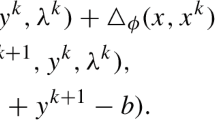Abstract
We consider reformulations of a class of bilevel linear integer programs as equivalent linear mixed-integer programs (linear MIPs). The most common technique to reformulate such programs as a single-level problem is to replace the lower-level linear optimization problem by Karush–Kuhn–Tucker (KKT) optimality conditions. Employing the strong duality (SD) property of linear programs is an alternative method to perform such transformations. In this note, we describe two SD-based reformulations where the key idea is to exploit the binary expansion of upper-level integer variables. We compare the performance of an off-the-shelf MIP solver with the SD-based reformulations against the KKT-based one and show that the SD-based approaches can lead to orders of magnitude reduction in computational times for certain classes of instances.
Similar content being viewed by others
References
Adams, W., & Forrester, R. (2007). Linear forms of nonlinear expressions: New insights on old ideas. Operations Research Letters, 35(4), 510–518.
Adams, W., & Henry, S. (2012). Base-2 expansions for linearizing products of functions of discrete variables. Operations Research, 60(6), 1477–1490.
Arroyo, J. M. (2010). Bilevel programming applied to power system vulnerability analysis under multiple contingencies. IET Generation, Transmission and Distribution, 4(2), 178–190.
Arroyo, J. M., & Galiana, F. D. (2005). On the solution of the bilevel programming formulation of the terrorist threat problem. IEEE Transactions on Power Systems, 20(2), 789–797.
Audet, C., Hansen, P., Jaumard, B., & Savard, G. (1997). Links between linear bilevel and mixed 0–1 programming problems. Journal of Optimization Theory and Applications, 93(2), 273–300.
Audet, C., Savard, G., & Zghal, W. (2007). New branch-and-cut algorithm for bilevel linear programming. Journal of Optimization Theory and Applications, 134(2), 353–370.
Bard, J. F., & Falk, J. E. (1982). An explicit solution to the multi-level programming problem. Computers and Operations Research, 9(1), 77–100.
Bard, J. F., & Moore, J. T. (1990). A branch and bound algorithm for the bilevel programming problem. SIAM Journal on Scientific and Statistical Computing, 11(2), 281–292.
Baringo, L., & Conejo, A. J. (2012). Transmission and wind power investment. IEEE Transactions on Power Systems, 27(2), 885–893.
Beheshti, B., Prokopyev, O. A., & Pasiliao, E. L. (2016). Exact solution approaches for bilevel assignment problems. Computational Optimization and Applications, 64(1), 215–242.
Bialas, W. F., & Karwan, M. H. (1984). Two-level linear programming. Management Science, 30(8), 1004–1020.
Borrero, J. S., Gillen, C., & Prokopyev, O. A. (2016). A simple technique to improve linearized reformulations of fractional (hyperbolic) 0–1 programming problems. Operations Research Letters, 44(4), 479–486.
Brown, G., Carlyle, M., Salmerón, J., & Wood, K. (2006). Defending critical infrastructure. Interfaces, 36(6), 530–544.
Campêlo, M., & Scheimberg, S. (2000). A note on a modified simplex approach for solving bilevel linear programming problems. European Journal of Operational Research, 126(2), 454–458.
Cao, D., & Chen, M. (2006). Capacitated plant selection in a decentralized manufacturing environment: A bilevel optimization approach. European Journal of Operational Research, 169(1), 97–110.
Caprara, A., Carvalho, M., Lodi, A., & Woeginger, G. J. (2013). A complexity and approximability study of the bilevel knapsack problem. In: M. Goemans & J. Correa (Eds.), Integer programming and combinatorial optimization 2013. Lecture Notes in Computer Science (vol. 7801, pp. 98–109). Springer Heidelberg.
Colson, B., Marcotte, P., & Savard, G. (2005). Bilevel programming: A survey. 4OR, 3(2), 87–107.
Colson, B., Marcotte, P., & Savard, G. (2007). An overview of bilevel optimization. Annals of Operations Research, 153(1), 235–256.
Corley, H, Jr., & Chang, H. (1974). Finding the \(n\) most vital nodes in a flow network. Management Science, 21(3), 362–364.
CPLEX, I. I. (2016). Available at http://www-01.ibm.com/software/info/ilog/. Accessed on 7 Jan (2016).
Dempe, S. (2002). Foundations of bilevel programming. Berlin: Springer Science & Business Media.
DeNegre, S. (2011). Interdiction and discrete bilevel linear programming. Ph.D. thesis, Lehigh University.
DeNegre, S. T., & Ralphs, T. K. (2009). A branch-and-cut algorithm for bilevel integer programming. In Proceedings of the 11th INFORMS computing society meeting (pp. 65–78).
Fortuny-Amat, J., & McCarl, B. (1981). A representation and economic interpretation of a two-level programming problem. Journal of The Operational Research Society, 32(9), 783–792.
Freire, A. S., Moreno, E., & Vielma, J. P. (2012). An integer linear programming approach for bilinear integer programming. Operations Research Letters, 40(2), 74–77.
Fulkerson, D. R., & Harding, G. C. (1977). Maximizing the minimum source-sink path subject to a budget constraint. Mathematical Programming, 13(1), 116–118.
Garcés, L. P., Conejo, A. J., García-Bertrand, R., & Romero, R. (2009). A bilevel approach to transmission expansion planning within a market environment. IEEE Transactions on Power Systems, 24(3), 1513–1522.
Garcia-Herreros, P., Zhang, L., Misra, P., Arslan, E., Mehta, S., & Grossmann, I. E. (2016). Mixed-integer bilevel optimization for capacity planning with rational markets. Computers and Chemical Engineering, 86, 33–47.
Glover, F. (1975). Improved linear integer programming formulations of nonlinear integer problems. Management Science, 22(4), 455–460.
Glover, F., & Woolsey, E. (1974). Technical note: Converting the 0–1 polynomial programming problem to a 0–1 linear program. Operations Research, 22(1), 180–182.
Gupte, A., Ahmed, S., Cheon, M. S., & Dey, S. (2013). Solving mixed integer bilinear problems using MILP formulations. SIAM Journal on Optimization, 23(2), 721–744.
Hansen, P., Jaumard, B., & Savard, G. (1992). New branch-and-bound rules for linear bilevel programming. SIAM Journal on Scientific and Statistical Computing, 13(5), 1194–1217.
Jeroslow, R. G. (1985). The polynomial hierarchy and a simple model for competitive analysis. Mathematical Programming, 32(2), 146–164.
Júdice, J. J., & Faustino, A. (1988). The solution of the linear bilevel programming problem by using the linear complementarity problem. Investigação Operacional, 8(1), 77–95.
McCormick, G. P. (1976). Computability of global solutions to factorable nonconvex programs: Part I-convex underestimating problems. Mathematical Programming, 10(1), 147–175.
Migdalas, A., Pardalos, P., & Värbrand, P. (1998). Multilevel optimization: Algorithms and applications. Norwell: Kluwer.
Morales, J. M., Pinson, P., & Madsen, H. (2012). A transmission-cost-based model to estimate the amount of market-integrable wind resources. IEEE Transactions on Power Systems, 27(2), 1060–1069.
Motto, A. L. (2005). On the exact solution of a class of stackelberg games. In Proceedings of the 2005, American control conference, 2005 (pp. 249–250). IEEE.
Motto, A. L., Arroyo, J. M., & Galiana, F. D. (2005). A mixed-integer lp procedure for the analysis of electric grid security under disruptive threat. IEEE Transactions on Power Systems, 20(3), 1357–1365.
Pandzic, H., Conejo, A. J., & Kuzle, I. (2013). An EPEC approach to the yearly maintenance scheduling of generating units. IEEE Transactions on Power Systems, 28(2), 922–930.
Pandzic, H., Conejo, A. J., Kuzle, I., & Caro, E. (2012). Yearly maintenance scheduling of transmission lines within a market environment. IEEE Transactions on Power Systems, 27(1), 407–415.
Pozo, D., Sauma, E. E., & Contreras, J. (2013). A three-level static milp model for generation and transmission expansion planning. IEEE Transactions on Power Systems, 28(1), 202–210.
Rider, M. J., López-Lezama, J. M., Contreras, J., & Padilha-Feltrin, A. (2013). Bilevel approach for optimal location and contract pricing of distributed generation in radial distribution systems using mixed-integer linear programming. IET Generation, Transmission and Distribution, 7(7), 724–734.
Ruiz, C., Conejo, A. J., & Smeers, Y. (2012). Equilibria in an oligopolistic electricity pool with stepwise offer curves. IEEE Transactions on Power Systems, 27(2), 752–761.
Sherali, H., & Smith, J. (2007). An improved linearization strategy for zero–one quadratic programming problems. Optimization Letters, 1(1), 33–47.
Tang, Y., Richard, J., & Smith, J. (2015). A class of algorithms for mixed-integer bilevel min–max optimization. Journal of Global Optimization, 66, 1–38.
Vielma, J., & Nemhauser, G. (2011). Modeling disjunctive constraints with a logarithmic number of binary variables and constraints. Mathematical Programming, 128(1–2), 49–72.
Watters, L. (1967). Reduction of integer polynomial programming problems to zero–one linear programming problems. Operations Research, 15(6), 1171–1174.
Wu, T. H. (1997). A note on a global approach for general 0–1 fractional programming. European Journal of Operational Research, 101(1), 220–223.
Ye, H., Wang, J., & Li, Z. (2016). MIP reformulation for max–min problems in two-stage robust SCUC. IEEE Transactions on Power Systems, PP(99), 1237–1247.
Zeng, B., & An, Y. (2014). Solving bilevel mixed integer program by reformulations and decomposition. Optimization On-line.
Zenklusen, R. (2010). Matching interdiction. Discrete Applied Mathematics, 158(15), 1676–1690.
Acknowledgements
The authors thank two anonymous referees and the Associate Editor for their constructive and helpful comments. This material is based upon work partially supported by the National Science Foundation [Grant CMMI-1634835]. The research of Oleg A. Prokopyev was in part performed while visiting the National Research University Higher School of Economics (Nizhny Novgorod), and was supported by the Laboratory of Algorithms and Technologies for Network Analysis (LATNA) and RSF grant 14-41-00039.
Author information
Authors and Affiliations
Corresponding author
Rights and permissions
About this article
Cite this article
Zare, M.H., Borrero, J.S., Zeng, B. et al. A note on linearized reformulations for a class of bilevel linear integer problems. Ann Oper Res 272, 99–117 (2019). https://doi.org/10.1007/s10479-017-2694-x
Published:
Issue Date:
DOI: https://doi.org/10.1007/s10479-017-2694-x




